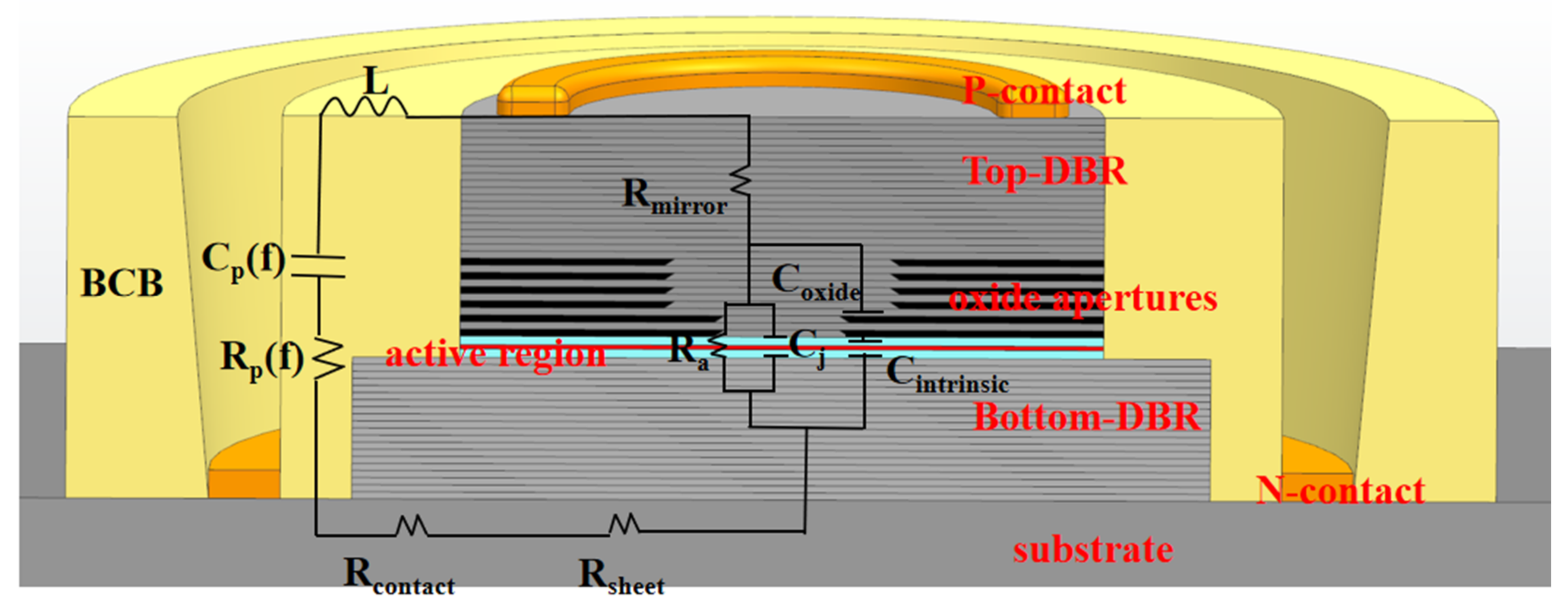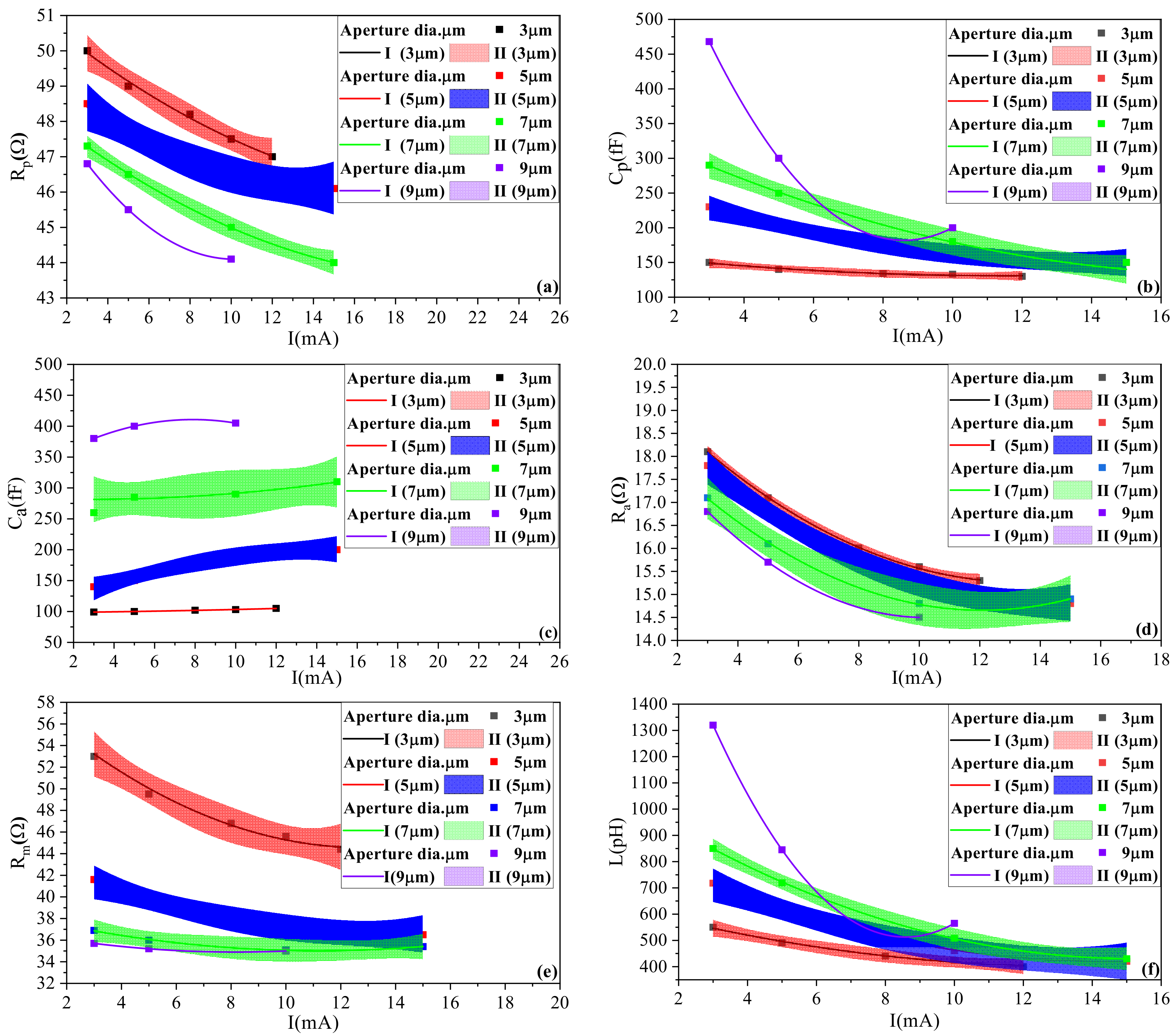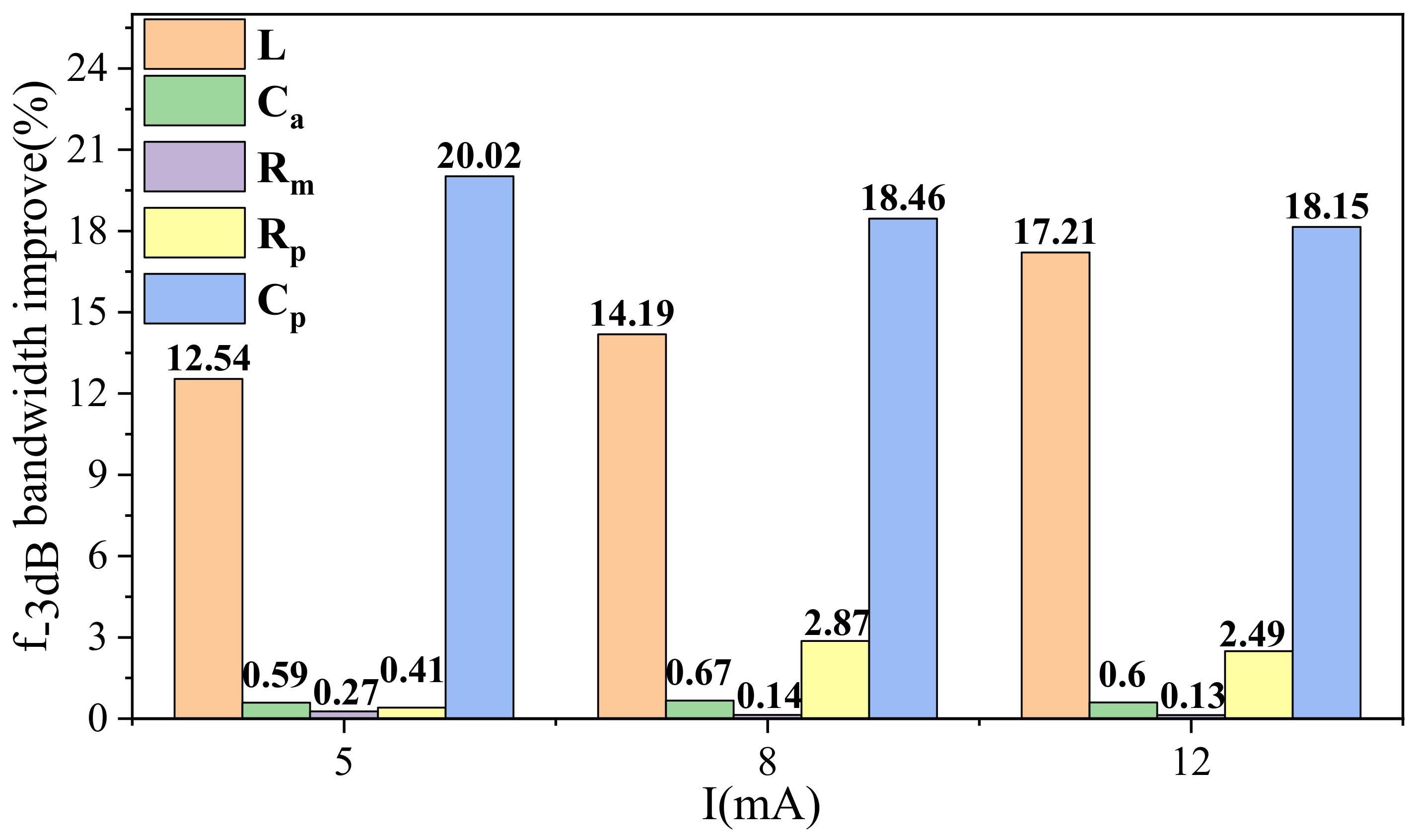Parasitic Parameters Extraction of High-Speed Vertical-Cavity Surface-Emitting Lasers
Abstract
:1. Introduction
2. Materials and Methods
2.1. Fabrication and Performance of the Six-Layer Oxide Aperture VCSEL
2.2. Equivalent Circuit Model
2.3. Parasitic Extraction Method
3. Results and Discussion
3.1. Parameter Extraction and Analysis
3.2. Bandwidth Improvement Suggestions
4. Conclusions
Author Contributions
Funding
Institutional Review Board Statement
Informed Consent Statement
Data Availability Statement
Conflicts of Interest
References
- Hecht, U.; Ledentsov, N.J.; Chorchos, L. 120 Gbits multi-mode fiber transmission realized with feed forward equalization using 28 GHz 850 nm VCSELs. In Proceedings of the 45th European Conference on Optical Communication (ECOC 2019), Dublin, Ireland, 22–26 September 2019. [Google Scholar]
- Westbergh, P.; Gustavsson, J.S.; Kogel, B.; Haglund, A.; Larsson, A.; Mutig, A.; Nadtochiy, A.; Bimberg, D.; Joel, A. 40 Gbit/s error-free operation of oxide-confined 850 nm VCSEL. Electron. Lett. 2010, 46, 1014–1016. [Google Scholar] [CrossRef] [Green Version]
- Westbergh, P.; Haglund, E.P.; Haglund, E.; Safaisini, R.; Gustavsson, J.S.; Larsson, A. High-speed 850 nm VCSELs operating error free up to 57 Gbit/s. Electron. Lett. 2013, 49, 1021–1023. [Google Scholar] [CrossRef] [Green Version]
- Westbergh, P.; Safaisini, R.; Haglund, E.; Kögel, B.; Gustavsson, J.S.; Larsson, A.; Geen, M.; Lawrence, R.; Joel, A. High-speed 850 nm VCSELs with 28 GHz modulation bandwidth operating error-free up to 44 Gbit/s. Electron. Lett. 2012, 48, 1145–1147. [Google Scholar] [CrossRef] [Green Version]
- Haglund, E.; Westbergh, P.; Gustavsson, J.S.; Haglund, E.P.; Larsson, A.; Geen, M.; Joel, A. 30 GHz bandwidth 850 nm VCSEL with sub-100 fJ/bit energy dissipation at 25–50 Gbit/s. Electron. Lett. 2015, 51, 1096–1098. [Google Scholar] [CrossRef] [Green Version]
- Majewski, M.L.; Novak, D. Method for characterization of intrinsic and extrinsic components of semiconductor laser diode circuit model. IEEE Microw. Guided Wave Lett. 1991, 1, 246–248. [Google Scholar] [CrossRef]
- Bruensteiner, M.; George, C.P. Extraction of VCSEL Rate-Equation Parameterys for Low-Bias System Simulation. IEEE J. Sel. Top. Quantum Electron. 1999, 5, 487–494. [Google Scholar] [CrossRef]
- Minoglou, K.; Kyriakis-Bitzaros, E.D.; Syvridis, D.; Halkias, G. A Compact Nonlinear Equivalent Circuit Model and Parameter Extraction Method for Packaged High-Speed VCSELs. J. Light. Technol. 2004, 22, 2823–2827. [Google Scholar] [CrossRef]
- Gao, J.J.; Li, X.P.; Flucke, J.; Boeck, G. Direct Parameter-Extraction Method for Laser Diode Rate-Equation Model. J. Light. Technol. 2004, 22, 1604–1609. [Google Scholar] [CrossRef]
- Principato, F.; Ferrante, G.; Marin, F. Coherence functions of the electrical and the optical noises in monomodal packaged vertical cavity surface emitting lasers. Laser Phys. Lett. 2007, 4, 204–211. [Google Scholar] [CrossRef]
- Ou, Y.; Gustavsson, J.S.; Westbergh, P.; Haglund, Å.; Larsson, A.; Joel, A. Impedance Characteristics and Parasitic Speed Limitations of High-Speed 850-nm VCSELs. IEEE Photon. Technol. Lett. 2009, 21, 1840–1842. [Google Scholar] [CrossRef]
- Gao, J. High Frequency Modeling and Parameter Extraction for Vertical-Cavity Surface Emitting Lasers. J. Light. Technol. 2012, 30, 1757–1763. [Google Scholar] [CrossRef]
- Hamad, W.; Sanayeh, M.B.; Siepelmeyer, T.; Hamad, H.; Werner, H.E.H. Small-Signal Analysis of High-Performance VCSELs. IEEE Photon. J. 2019, 11, 1501212. [Google Scholar] [CrossRef]
- Hamad, W.; Marwan, B.S.; Mustapha, M.H.; Werner, H.E.H. Impedance Characteristics and Chip-Parasitics Extraction of High-Performance VCSELs. IEEE J. Quantum Electron. 2020, 56, 2400111. [Google Scholar] [CrossRef]
- Miah, M.J.; Al-Samaneh, A.; Kern, A.; Wahl, D.; Debernardi, P.; Michalzik, R. Fabrication and Characterization of Low-Threshold Polarization-Stable VCSELs for Cs-Based Miniaturized Atomic Clocks. IEEE J. Sel. Top. Quantum Electron. 2013, 19, 1701410. [Google Scholar] [CrossRef]
- Al-Samaneh, A.; Sanayeh, M.B.; Renz, S.; Wahl, D.; Michalzik, R. Polarization Control and Dynamic Properties of VCSELs for MEMS Atomic Clock Applications. IEEE Photon. Technol. Lett. 2011, 23, 1049–1051. [Google Scholar] [CrossRef]
- Larsson, A. Advances in VCSELs for Communication and Sensing. IEEE J. Sel. Top. Quantum Electron. 2011, 17, 1552–1567. [Google Scholar] [CrossRef]
- Al-Omari, A.N.; Al-Kofahi, I.K.; Lear, K.L. Fabrication, performance and parasitic parameter extraction of 850 nm high-speed vertical-cavity lasers. Semicond. Sci. Technol. 2009, 24, 095024. [Google Scholar] [CrossRef]
- Blokhin, S.A.; Maleev, N.A.; Bobrov, M.A.; Kuzmenkov, A.G.; Sakharov, A.V.; Ustinov, V.M. High-Speed Semiconductor Vertical-Cavity Surface-Emitting Lasers for Optical Data-Transmission Systems (Review). Tech. Phys. Lett. 2018, 44, 1–16. [Google Scholar] [CrossRef]
- Li, H.; Lott, J.A.; Wolf, P.; Moser, P.; Larisch, G.; Bimberg, D. Temperature-Dependent Impedance Characteristics of Temperature-Stable High-Speed 980-nm VCSELs. IEEE Photon. Technol. Lett. 2015, 27, 832–835. [Google Scholar] [CrossRef]
- Hamad, W.; Sanayeh, M.B.; Hosn, B.A.; Ajemian, V.; Yehia, R.; Zouein, E.; Hamad, M.; Hofmann, W. Modulation response, impedance, and equivalent circuit of ultra-high-speed multi-mode VCSELs. In Semiconductor Lasers and Applications VIII; SPIE: Bellingham, WA, USA, 2018. [Google Scholar]
- Barsoukov, E.; Macdonald, J.R. Impedance Spectroscopy: Theory, Experiment, and Applications, 3rd ed.; John Wiley & Sons: Hoboken, NJ, USA, 2018; pp. 166–174. [Google Scholar]
- Al-Omari, A.N.; Lear, K.L. Dielectric characteristics of spin-coated dielectric films using on-wafer parallel-plate capacitors at microwave frequencies. IEEE Trans. Dielectr. Electr. Insul. 2005, 12, 1151–1161. [Google Scholar] [CrossRef]
- Lawson, C.L.; Hanson, R.J. Solving Least Squares Problems; Robert, E., O’Malley, J., Eds.; University of Washington: Seattle, WA, USA, 1987; pp. 5–9. [Google Scholar]
- Lv, Z.C. The Study of High Speed 850nm VCSEL Array. Ph.D. Thesis, Beijing University of Technology, Beijing, China, 2018; p. 919. (In Chinese). [Google Scholar]
- Liang, C.; Zhang, W.; Wang, Q.; Yao, S.; He, Z. Application-Oriented Investigation of Parasitic Limitation on Multilevel Modulation of High-Speed VCSELs. IEEE Photon. J. 2019, 11, 1502210. [Google Scholar] [CrossRef]







| f−3 dB (GHz) | |||||||
|---|---|---|---|---|---|---|---|
| Current (mA) | Original Value of f−3 dB | L ↓ 30% | Ca ↓ 30% | Ra ↓ 30% | Rm ↓ 30% | Rp ↓ 30% | Cp ↓ 30% |
| 5 | 18.63 | 21.3 | 18.74 | 18.63 | 18.68 | 19.39 | 22.20 |
| 8 | 21.23 | 24.74 | 21.37 | 21.23 | 21.26 | 21.84 | 25.15 |
| 12 | 23.3 | 27.31 | 23.44 | 23.3 | 23.33 | 23.88 | 27.53 |
Publisher’s Note: MDPI stays neutral with regard to jurisdictional claims in published maps and institutional affiliations. |
© 2022 by the authors. Licensee MDPI, Basel, Switzerland. This article is an open access article distributed under the terms and conditions of the Creative Commons Attribution (CC BY) license (https://creativecommons.org/licenses/by/4.0/).
Share and Cite
Tong, H.; Wang, Y.; Tian, S.; Tong, C.; Wei, Z.; Wang, L. Parasitic Parameters Extraction of High-Speed Vertical-Cavity Surface-Emitting Lasers. Appl. Sci. 2022, 12, 6035. https://doi.org/10.3390/app12126035
Tong H, Wang Y, Tian S, Tong C, Wei Z, Wang L. Parasitic Parameters Extraction of High-Speed Vertical-Cavity Surface-Emitting Lasers. Applied Sciences. 2022; 12(12):6035. https://doi.org/10.3390/app12126035
Chicago/Turabian StyleTong, Haixia, Yanjing Wang, Sicong Tian, Cunzhu Tong, Zhipeng Wei, and Lijun Wang. 2022. "Parasitic Parameters Extraction of High-Speed Vertical-Cavity Surface-Emitting Lasers" Applied Sciences 12, no. 12: 6035. https://doi.org/10.3390/app12126035
APA StyleTong, H., Wang, Y., Tian, S., Tong, C., Wei, Z., & Wang, L. (2022). Parasitic Parameters Extraction of High-Speed Vertical-Cavity Surface-Emitting Lasers. Applied Sciences, 12(12), 6035. https://doi.org/10.3390/app12126035







